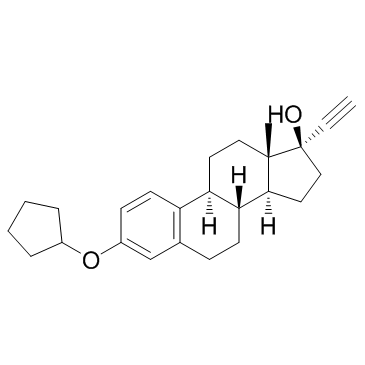Behavioral evaluation of quinestrol as a sterilant in male Brandt's voles.
Dawei Wang, Ning Li, Ming Liu, Baohuan Huang, Qi Liu, Xiaohui Liu
Index: Physiol. Behav. 104(5) , 1024-30, (2011)
Full Text: HTML
Abstract
The theoretical, ecological, physiological, and mathematical aspects of fertility control in mammals have already been well studied, but little attention has been given to the behavioral effects, especially in rodents. We investigated the effects of quinestrol, a synthetic estradiol analog, on social behavior and reproductive physiology in male Brandt's voles (Lasiopodomys brandtii). Over seven successive days, four concentration gradients of quinestrol (none, 0.001%, 0.003%, and 0.006%) were separately mixed into feed and provided to male Brandt's voles. Reproductive parameters, including the reproductive organ indexes, testosterone level and reproductive ability, were observed and collected 2 weeks after finished feeding treatment and again after 4 weeks. Dyadic social encounters and female preferences were then recorded for the control males (no quinestrol) and the highest concentration group (0.006%). Results showed that quinestrol reduced the consumption of feed. Physiological data revealed that quinestrol had also effectively reduced the reproductive organs indexes, testosterone levels, female pregnancy rates and litter size. This phenomenon was especially evident in the highest concentration group only after 2 weeks of feeding. Behavioral results showed that both frequency and duration of female preference were unbiased between control and treated males. In social conflict tests, control pairs (CC) had lower latency toward initial attack than treated pairs (TT) and pairs of one control and one treated male (CT). Among the three pairs, there was no evident difference in patterns of mutual attack and agonistic behavior. In CT pairs, sterile males have the same winning rate and agonistic behavior as control males. Our data revealed that quinestrol has anti-fertility capabilities with little behavioral side effects on Brandt's voles, which suggested quinestrol's potential as a sterilant for Brandt's voles. The palatability, however, should be improved before field practice.Copyright © 2011 Elsevier Inc. All rights reserved.
Related Compounds
| Structure | Name/CAS No. | Molecular Formula | Articles |
|---|---|---|---|
 |
Quinestrol
CAS:152-43-2 |
C25H32O2 |
|
The bioaccumulation and biotransformation of synthetic estro...
2014-10-01 [Aquat. Toxicol. 155 , 84-90, (2014)] |
|
Photodegradation of quinestrol in waters and the transformat...
2012-11-01 [Chemosphere 89(11) , 1419-25, (2012)] |
|
Effects of quinestrol on reproductive hormone expression, se...
2012-04-01 [Theriogenology 77(6) , 1223-31, (2012)] |
|
Quinestrol treatment induced testicular damage via oxidative...
2011-01-01 [Exp. Anim. 60(5) , 445-53, (2011)] |
|
Subfertile effects of quinestrol and levonorgestrel in male ...
2012-01-01 [Reprod. Fertil. Dev. 24(2) , 297-308, (2012)] |